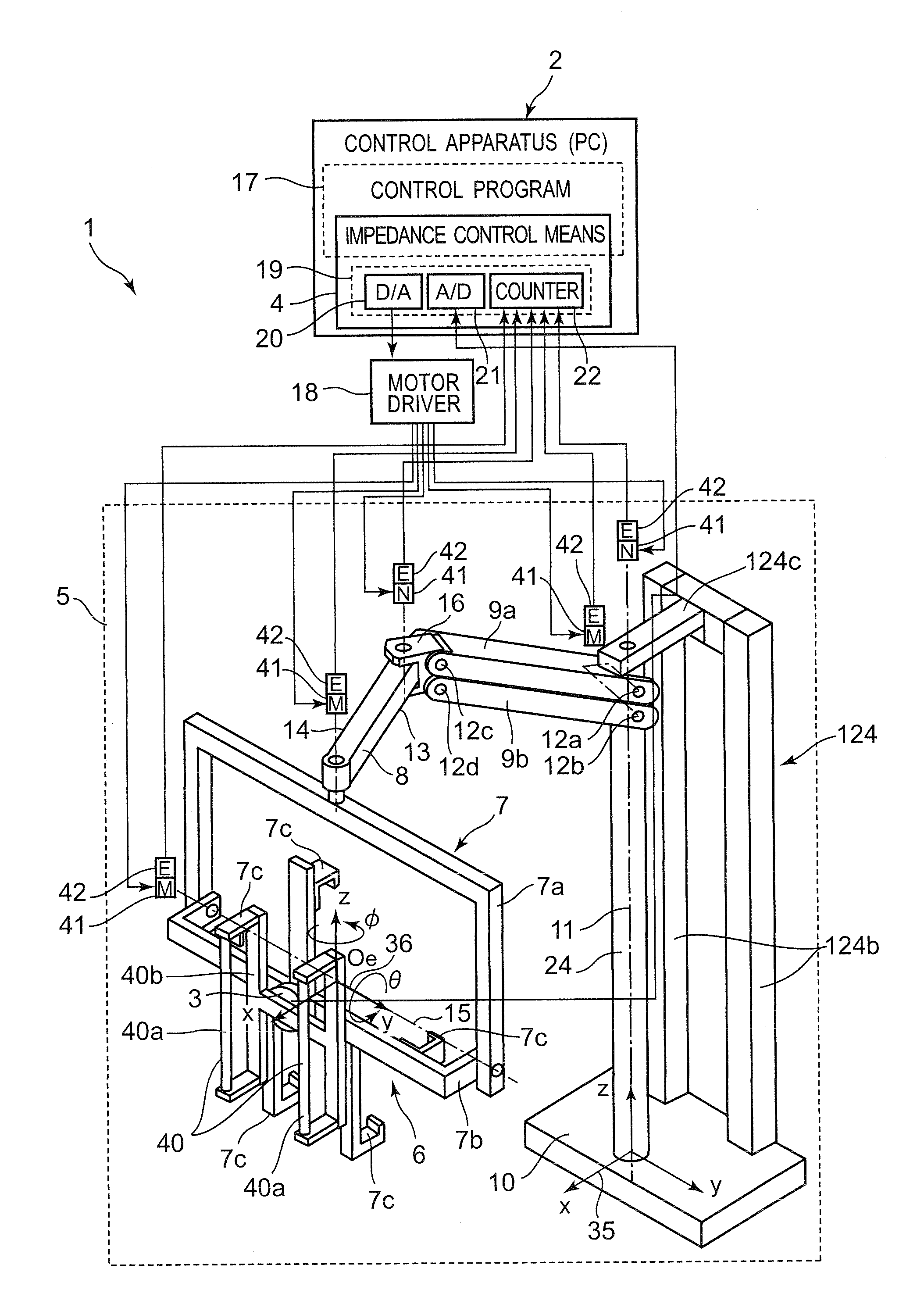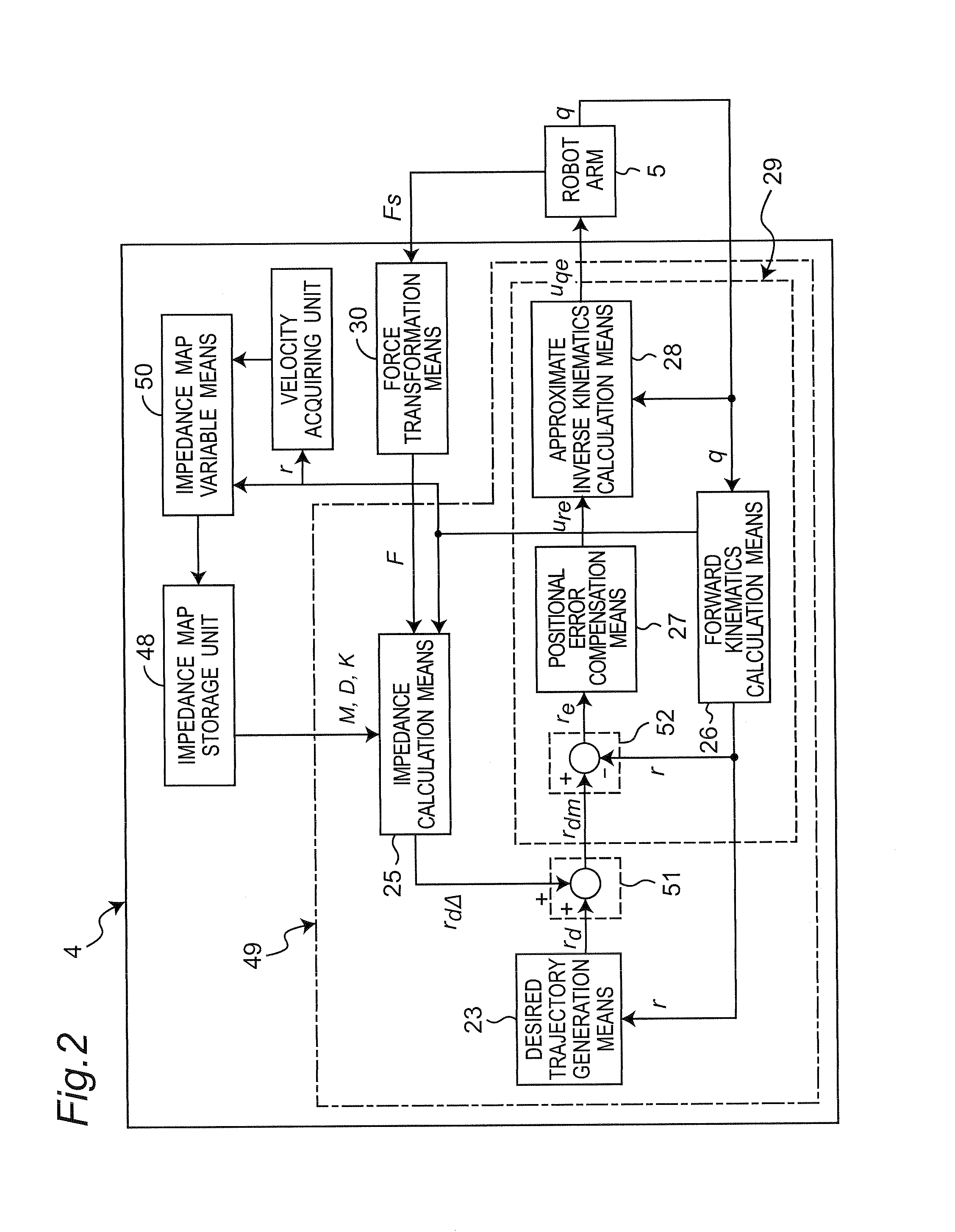Robot, robot control apparatus, robot control method, and robot control program
- Summary
- Abstract
- Description
- Claims
- Application Information
AI Technical Summary
Benefits of technology
Problems solved by technology
Method used
Image
Examples
first embodiment
[0089]FIG. 1 shows the structure of a robot 1 according to a first embodiment of the present disclosure. The robot 1 includes a multi-joint robot arm 5, and a control apparatus 2 that controls the operation of the multi-joint robot arm 5.
[0090]The control apparatus 2 is structured by an ordinary personal computer in hardware. Further, the control apparatus 2 except for an input / output IF 19 of an impedance control means (an impedance control unit) 4 is realized in software as a control program 17 executed by the personal computer.
[0091]The input / output IF 19 is structured by a D / A board 20, an A / D board 21, and a counter board 22 each connected to an extension slot such as a PCI bus of the personal computer.
[0092]Execution of the control program 17 for controlling the operation of the multi-joint robot arm 5 of the robot 1 enables the control apparatus 2 to function.
[0093]Joint angle information which is output from an encoder 42 serving as one example of a joint angle sensor of eac...
second embodiment
[0152]The basic structure of a robot 1 according to the second embodiment of the present disclosure is identical to that according to the first embodiment shown in FIGS. 1 and 2. Therefore, the description of the common parts will not be repeated, and the difference will solely be detailed below.
[0153]In the second embodiment, as shown in FIGS. 9A and 9B, the initial state of the impedance map storage unit 48, that is, the impedance map of the reference distribution (the distribution serving as the reference before any changed or update is made, or the distribution in the initial state) of the impedance parameters M, D, and K (inertia M, damping D, and stiffness K) stored in the impedance map storage unit 48 is structured by: a first region 101 of low damping for allowing the arm end of the robot arm 5 to shift; a second region 102 of damping higher than that of the first region 101 for allowing the arm end of the robot arm 5 to be positioned; and a third region 103 of damping highe...
third embodiment
[0156]The basic structure of a robot 1 according to a third embodiment of the present disclosure is identical to that according to the first embodiment shown in FIGS. 1 and 2. Therefore, the description of the common parts will not be repeated, and the difference will solely be detailed below.
[0157]In the third embodiment, as shown in FIG. 10A, in the initial state of the impedance map storage unit 48, a second wall 54A, whose damping D is high near the stand 33 of the second workbench 32, is formed as the fourth region 104. More specifically, the initial state of the impedance map storage unit 48, that is, the impedance map of the reference distribution (the distribution serving as the reference before any changed or update is made, or the distribution in the initial state) of the impedance parameters M, D, and K (inertia M, damping D, and stiffness K) stored in the impedance map storage unit 48 has: a first region 101 of low damping for allowing the hand 6 of the robot arm 5 to sh...
PUM
 Login to View More
Login to View More Abstract
Description
Claims
Application Information
 Login to View More
Login to View More - R&D
- Intellectual Property
- Life Sciences
- Materials
- Tech Scout
- Unparalleled Data Quality
- Higher Quality Content
- 60% Fewer Hallucinations
Browse by: Latest US Patents, China's latest patents, Technical Efficacy Thesaurus, Application Domain, Technology Topic, Popular Technical Reports.
© 2025 PatSnap. All rights reserved.Legal|Privacy policy|Modern Slavery Act Transparency Statement|Sitemap|About US| Contact US: help@patsnap.com



